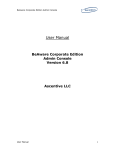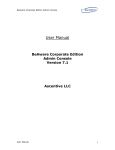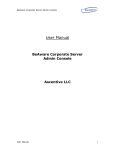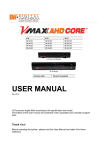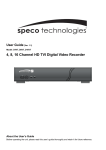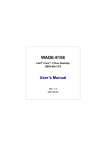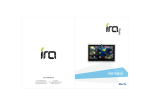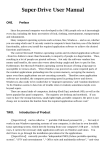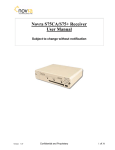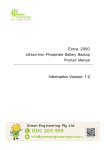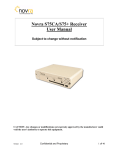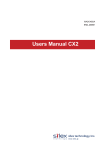Download 7.4 User Manual - BeAware Corporate
Transcript
BeAware Corporate Edition Manual User BeAware Corporate Edition User Manual 2009 ASCENTIVE LLC All rights reserved Document Version 1.0 1 BeAware Corporate Edition User Manual Copyright Notice Copyright © 2009 Ascentive LLC All Rights Reserved This document is protected by copyright law and internationals treaties. Unauthorized reproduction or distribution of this document or any portion of it, without prior permission from Ascentive LLC may result in severe civil and criminal penalties, and will be prosecuted to the maximum extent possible under the law. Trademarks Ascentive, the Ascentive logo, and BeAware are trademarks of Ascentive LLC. AIM and AOL are registered trademarks or trademarks of America Online. Microsoft, Windows, MSN, MSN Messenger, Outlook, Outlook Express, Hotmail, Internet Explorer are registered trademarks or trademarks of Microsoft Corporation in the United States and other countries. Yahoo! and Yahoo! Messenger are registered trademarks of Yahoo!, Inc. IncrediMail is a registered trademark of IncrediMail. Thunderbird is a registered trademark or trademark of Mozilla. Document Version 1.0 2 BeAware Corporate Edition User Manual TABLE OF CONTENTS 1. 1.1 1.2 1.3 INTRODUCTION ..................................................................................................5 OVERVIEW ........................................................................................................5 HOW TO USE THIS MANUAL… ............................................................................5 REFERENCES ....................................................................................................5 2. 2.1 SYSTEM DESCRIPTION .......................................................................................6 APPLICATION OVERVIEW ....................................................................................6 3. LOGGING IN TO BEAWARE .................................................................................7 4. 4.1 4.2 4.3 4.4 ACTIVATING THE LICENSE ................................................................................ 11 LICENSE KEYS................................................................................................. 11 LICENSE MANAGER.......................................................................................... 11 ADDING A LICENSE ........................................................................................... 13 DELETING A LICENSE ....................................................................................... 14 5. 5.1 5.2 5.3 5.4 CONFIGURING SYSTEM SETTINGS .................................................................... 15 CONNECTION STATUS ...................................................................................... 15 BACKUP/RESTORE .......................................................................................... 16 SERVER ALERTS ............................................................................................. 19 DATA MANAGEMENT ........................................................................................ 21 6. 6.1 6.2 CREATING USERS AND WORKGROUPS ............................................................. 27 MANAGING USERS ........................................................................................... 27 MANAGING W ORKGROUPS ............................................................................... 29 7. 7.1 7.2 7.3 MONITORING APPLICATIONS ............................................................................ 33 SORTING THE RECORDS ................................................................................... 34 PRINTING THE CAPTURED DATA ........................................................................ 34 DELETING RECORD.......................................................................................... 34 8. 8.1 8.2 8.3 MONITORING CHATS ........................................................................................ 35 SORTING THE RECORDS ................................................................................... 36 PRINTING THE CAPTURED DATA ........................................................................ 36 DELETING RECORD.......................................................................................... 36 9. 9.1 9.2 MONITORING E-MAIL ....................................................................................... 37 SENT EMAIL..................................................................................................... 37 RECEIVED EMAIL.............................................................................................. 39 10. 10.1 10.2 10.3 10.4 TAKING SCREEN CAPTURES ............................................................................. 41 SORTING THE RECORDS ................................................................................... 41 PRINTING THE CAPTURED DATA ........................................................................ 42 VIEWING AS SLIDE SHOW .................................................................................. 42 DELETING RECORD.......................................................................................... 44 11. 11.1 11.2 11.3 MONITORING WEBSITES .................................................................................. 45 SORTING THE RECORDS ................................................................................... 46 PRINTING THE CAPTURED DATA ........................................................................ 46 DELETING RECORD.......................................................................................... 46 12. 12.1 12.2 12.3 MONITORING WINDOWS SESSIONS ................................................................... 47 SORTING THE RECORDS ................................................................................... 47 PRINTING THE CAPTURED DATA ........................................................................ 48 DELETING RECORD.......................................................................................... 48 13. 13.1 SEARCH ACTIVITY ........................................................................................... 49 APPLICATIONS ................................................................................................. 50 Document Version 1.0 3 BeAware Corporate Edition User Manual 13.2 13.3 13.4 CHATS ............................................................................................................ 51 EMAILS ........................................................................................................... 52 WEB SITES ...................................................................................................... 54 14. 14.1 14.2 14.3 14.4 CONFIGURING PC ACTIVITY ALERTS ................................................................ 55 SETTING A PC ACTIVITY ALERT ........................................................................ 56 SETTING AN ALERT FOR ANY CATEGORY ............................................................ 57 SORTING THE RECORDS ................................................................................... 57 DELETING AN ALERT ........................................................................................ 57 15. MANAGING RELATIONSHIP PROFILER ............................................................... 58 16. 16.1 16.2 16.3 GENERATING REPORTS ................................................................................... 60 VIEWING ACTIVITY-BASED REPORTS ................................................................. 60 VIEWING TIME-BASED REPORTS ....................................................................... 63 VIEWING W ORKGROUP-BASED REPORTS .......................................................... 64 17. BCE ERROR REPORTING SERVICE ................................................................... 66 18. TROUBLESHOOTING TIPS & FAQ ..................................................................... 70 Document Version 1.0 4 BeAware Corporate Edition User Manual 1. INTRODUCTION 1.1 OVERVIEW Welcome to the BeAware Corporate Edition User Manual. This document will guide you through the procedures for configuring and using the BeAware Admin Console application. 1.2 HOW TO USE THIS MANUAL… The following symbols have been used throughout this manual: Indicates notes or significant points relevant to the procedural steps Indicates configuration settings which could cause problems with system setup; read the text carefully before proceeding further Indicates additional information relevant to the procedure 1.3 REFERENCES The following documents discuss the specific aspects of BeAware system in more detail. Sr. No. 1. Document Name BeAware Installation Guide Document Version 1.0 Description Describes in detail the steps to install the BeAware Monitoring Tool 5 BeAware Corporate Edition User Manual 2. SYSTEM DESCRIPTION 2.1 APPLICATION OVERVIEW BeAware is a surveillance system for your organization. It takes screen shots and records all the activities on the monitored PC. It enables you to view the web sites visited, Internet chats, email sessions, documents created, applications used, startup and shutdown times, and games played by the user. No other program offers so many easy options for monitoring computers and Internet activity than BeAware. Most of these special functions are configurable, for example setting the image resolution of Screen Captures. BeAware Corporate Server enables you to monitor your employees and achieve maximum productivity at work. The BeAware system makes sure that you don’t miss a thing! BeAware is compatible with Windows NT, Windows 2000, Windows XP, Windows Server 2003 and Windows Server 2008 (32-bit and 64-bit). BeAware monitoring client is compatible with Windows Vista (32-bit and 64-bit) Document Version 1.0 6 BeAware Corporate Edition User Manual 3. LOGGING IN TO BEAWARE You can choose either of the following two ways to log in to BeAware: 1. Double-click the BeAware Admin Console icon from desktop OR Select Start → Programs → Ascentive → BCS Admin Console Log In window appears. In case of fresh installation, you need to configure the settings for connecting to BeAware Server. To configure this, click the Settings button. It is recommended that you use the default settings. Document Version 1.0 7 BeAware Corporate Edition User Manual Screen Capture 1 - Server Settings (Advance Users) 2. Provide the following BeAware Server information to connect to the Server. • • • • Database Server Name: Enter Database Server name that you wish to connect to. Format of the settings is as follows: o For MSDE: [SERVERNAME]\BCS o For SQL Server: [SERVERNAME] Database Username: Enter Database Username for the server to which you wish to connect. Database Password: Enter Database Password for the server to which you wish to connect. Server Name: Enter name of the Server to which you wish to connect. 3. Click Apply button to complete the BeAware Server Configuration settings. If you wish to cancel saving the settings, click the Cancel button. If you wish to verify the settings before saving them, click the Test button. A confirmation message appears. Click OK to close the message. Document Version 1.0 8 BeAware Corporate Edition User Manual When you click Apply button, Log In window appears. 4. Enter your username and password and click Login button. BeAware splash screen appears for a few seconds as the application loads. Overview screen appears which displays all the functionalities provided by the BeAware Monitoring Tool. Document Version 1.0 9 BeAware Corporate Edition User Manual Document Version 1.0 10 BeAware Corporate Edition User Manual 4. ACTIVATING THE LICENSE The first time you use BeAware, you must activate your License Keys. If you do not activate your keys, you will not be able to access the Admin application and no data upload will be allowed from the monitored machines. The License Manager page enables you to purchase and activate the licenses required to operate the BeAware Monitoring Tool. 4.1 LICENSE KEYS BeAware has two types of Licenses: • Server License: Activates the BeAware Server to allow upload, storage, and viewing the captured data. • Seat License: The seat account can be used as Admin or Agent. Admin accounts allow full control of the BeAware system and access to the Admin application to view data, make system changes and configure the users. Agent accounts only allow uploading. Agents can not access the Admin application or make configuration changes. The server license allows you to install BeAware server application and Seat license allows you to install Admin and/or Agent application on a computer. Each key allows a specific number of users to access the BeAware application. License keys are machine-specific and the application will only work from the machine where the license key was installed for the first time. The BeAware license keys are created by using the unique hardware configuration of the computer. A license key activated for a particular computer cannot be installed on the other computer. For example, if you purchase 10 seat licenses and install the application on 10 machines, the application will work only from those 10 machines. In case, a machine with a license key goes out of order, you need to call Ascentive sales representatives to get new license keys. 4.2 LICENSE MANAGER When you log in after a fresh installation, the License Manager panel appears by default. This panel can also be accessed by selecting System Settings option under Settings section. Document Version 1.0 11 BeAware Corporate Edition User Manual Product License Manager page displays the following information: • Serial Number: Displays the serial number entered for the concerned server, admin or agent. The close Lock icon displays that the category Serial Number is not activated. The open Lock icon displays that the category serial number is activated. • Verification Key: Displays the verification key that has been allotted to the concerned server, admin or agent. • License Count: It displays number of licenses allotted to a particular category. Document Version 1.0 12 BeAware Corporate Edition User Manual 4.3 ADDING A LICENSE The License Manager tab allows registration of various categories of BeAware Corporate Server. 1. Select a category from the License Category drop down list. 2. Click Add button to enter License for selected category. Add License dialog box appears, asking you to enter the Serial Key and Verification Key for the new category. The necessary serial keys will be provided to you by the vendor. 3. After entering the proper serial keys, click OK button to register the new category. 4. Click the Activate button to activate the new category. The Activate License dialog box appears. Document Version 1.0 13 BeAware Corporate Edition User Manual 5. Enter the details about the user for whom the software is to be registered. To ensure that no copies of the software may be shared with unlicensed users, your registration is tied to the ID number of the network card installed on the machine. By default, the active network card is selected automatically. If multiple cards exist in the machine, select one of the cards to which to tie your license. If for any reason the card is removed permanently from the system, you need to contact your sales representative or vendor for replacement keys in order to continue using BeAware. 6. Once you have entered all the information and selected the network card to lock your license to, click OK button to activate the category. A confirmation message appears, indicating activation by an open lock icon. 4.4 DELETING A LICENSE Click Delete button to delete the license key that is added but not activated. Document Version 1.0 14 BeAware Corporate Edition User Manual 5. CONFIGURING SYSTEM SETTINGS 5.1 CONNECTION STATUS Connection Status tab displays details of all the machines connected to the BeAware Server and their current status. Connection Status tab displays the following information: • • • • • • Machine Name: Displays the machine name of the user. Windows Username: Displays the logged in user’s name on the target PC. Client Type: Displays the category of the user (Agent/Admin Console). Client Version: Displays the version number of the application installed on client’s machine. Local Connection (date/time): Displays the day, date and time at which the client was connected to server. Status: Displays the status of monitored machine. Lower section of the screen displays total seat licenses purchased, number of used licenses and remaining licenses. When the number of client machines connected to BeAware server exceeds the number of Seat licenses, the status message displays: ‘Client Limit Exceeded’ When a monitored client tries to connect to the server with incorrect username/password if the status displays: ‘Authentication Failure’ Document Version 1.0 15 BeAware Corporate Edition User Manual 5.2 BACKUP/RESTORE Backup/Restore facility allows you to copy (backup) the data from BeAware database server to your hard drive. You can also restore the backup data from the hard drive to BeAware database server. 1. Click System Settings under Settings. 2. Click Backup/Restore. Screen capture images are excluded from backup. You should manually backup the images. Document Version 1.0 16 BeAware Corporate Edition User Manual 5.2.1 Normal Backup Process 5.2.1.1 One Time a) Immediate Backup Choose this option for one-time backup. Specify the Backup Folder Name in the box and select backup options. Click Backup Now to take the backup. b) Scheduled Backup This option allows you to schedule backups. Select the option, select the scheduling options and click Set Rules button to schedule backup. c) Backup Name d) Normal Backup e) Delete data after Select this option, if you wish to delete the current working backup database after taking its backup. f) Auto Rename Select this option if you wish the system to automatically backup folder generate the backup folder name if you do not enter name with date: Backup Folder Name. The auto-generated folder will have the name as date and time. (E.G. 20060904_173403) g) Set Rules Set Rules saves the Rules specified by you for Normal Backup. h) Backup Now Click Backup Now to carry immediate backup. Your folder contains database files to be stored on the disk. i) One Time Select One Time Select the Date on which you wish the backup. Select the Time at which you wish the backup. Folder Enter Folder Name, which you wish to appear where your backup of database is kept. Document Version 1.0 Select Normal Backup for taking the backup and keeping the current working database. 17 BeAware Corporate Edition User Manual 5.2.1.2 Recurring j) Recurring k) Set l) Cancel Select this option if you wish to take database backup at different frequency and time. 1. Click Change 2. Recurring Schedule window opens 3. Select Daily or Weekly or Monthly Daily 1. Select Every 2. Select Occurs at 3. Click Set Daily backup automatically take place on selected days Time Weekly 1. Select Every 2. Select Day box. 3. Select Time Occurs at. 4. Click Set Weekly backup automatically takes place on selected week, Day and Time Monthly 1. Select Monthly Day 2. Select of Every month 3. Select Time Occurs at 4. Click Set Monthly backup automatically takes place on selected day of month and time. 1. Click Set button. 2. Set the rules for Recurring Backup. Recurring Schedule window closes. In Normal Backup Recurring, Folder is stored on disk with name, date and system auto generated number. (For example: Recurring20060831_162451) After successful database backup on disk, you can delete database files from the server. You can again restore those files on database server. System automatically creates database folder if you do not enter Backup Folder Name. Folder is created on the disk with date and auto generated number. (E.G. 20060904_173403) Select one of the options as described above and click Backup Now. If your data is deleted from database server, you can restore your database files on server and overwrite the data if any in database. Document Version 1.0 18 BeAware Corporate Edition User Manual Browse Restore Paths 3. 4. 5. 6. Click Select folder. The Restore Folder window displays. Double click selected folder. The folder shows in source folder box. Click Restore Now. Your database is restored on Server. Clicking on Reset button removes the folder name from Source Folder field. If the selected folder is not a valid restore path, then it is removed from Browse Restore Folder dialog. 5.3 SERVER ALERTS Server Alerts enable you to set up email alerts for server notification and warnings. 1. Click System Settings below the title Settings. 2. Click Set Server Email Alerts button in Backup/Restore window. This will redirect you to Server Alert window. Document Version 1.0 19 BeAware Corporate Edition User Manual 3. Click the Configure button. Mail Server Configuration dialog appears. Configure the SMTP server settings for sending the email alerts: • • • • Mail Server (Mandatory Field): Enter the mail server address through which email will be sent. E-mail Address (Mandatory Field): Enter a valid email address which uses the SMTP server to send the email. Username: Enter username used to logon the SMTP server. Password: Enter password set for the SMTP server. Document Version 1.0 20 BeAware Corporate Edition User Manual 4. To save the settings, click the Save button. To cancel saving the settings, click the Close button. 5. Next, you need to confirm the following settings: • Enable Email Alert: Select this option if you wish to send Email Alert. (By default, it is already selected) • Database Free Space Below: Select this option if you wish to receive an email alert when database space falls below the capacity specified by you. • Server Disk Free Space Below: Select this option if you wish to receive an email alert when server’s free disk space falls below the capacity specified by you. • Backup Initiated/Completed: Select this option if you wish to receive an email alert when the Backup process is initiated and completed. • Restore Initiated/Completed: Select this option if you wish to receive an email alert when the Restore process is initiated and completed. 6. Enter the Email Address to whom you wish to send the alert. 7. Click the Add button. The same email address will be displayed on the Send Alerts to box. 8. Click the Save Alert button from Save Alerts window. If you wish to delete any of the email address which you have already entered, click the particular email address in Send Alerts to box and Click the Delete button from Server Alerts window. Email alerts are also sent when license count is insufficient for connected PCs. 5.4 DATA MANAGEMENT Data Management tab allows you to: • View disk space details. • Archive old data to selected location or delete the data permanently. • Change data storage and backup locations. Document Version 1.0 21 BeAware Corporate Edition User Manual 5.4.1 Disk Space This section displays the following information: • Free Disk Space: The total free space available on the drive where BeAware Server stores the uploaded data. • Used Disk Space: This shows the total space consumed by BeAware Screen Capture data. • % Free Disk Space: It shows the percentage of free hard disk space on server machine. • Database Space Used: It displays the total space consumed by data stored in database, in addition to Used Disk space. If server is busy to calculating the sizes then at the place of figures it will display “Calculating…” 5.4.2 Data Management This section provides options to manage the captured data. Document Version 1.0 22 BeAware Corporate Edition User Manual 5.4.2.1 Data Cleanup This option allows you to delete data permanently. You can select data to be deleted by providing Data Filtering Options. 1. Select Data Cleanup. (It is selected by default.) 2. Click Data Filter button. Data Filtering Options window appears. 3. Specify the data to be considered for deletion. • Data Recorded Before: This option selects all the data captured before the given date. • Data Older than: You can keep latest data and delete data older than the days specified here. Only one of the options (either Data Recorded Before or Data older than) can be selected at a time. • Data Recorded for Windows User: First, select the box to enable this option. Next, specify the Windows username whose records you wish to delete from the drop down. If a Windows user is not specified, data of all the users will be deleted. Document Version 1.0 23 BeAware Corporate Edition User Manual • Data Recorded for Machine: First, select the box to enable this option. Next, select the machine name from the drop down. If a machine name is not specified, data of all machines will be deleted. • Data Recorded for Workgroup: First, select the box to enable this option. Next, specify the workgroup name from the drop-down. (If no workgroup has been created, this option remains disabled, until at-least one workgroup is created.) • Select Activity: You can select one or multiple PC Activities in order to delete data belonging to the specified criteria. To select the activity, select the box given against each activity. Either Windows User and Machine options, or Workgroup option can be selected at one time. That is, you cannot select Username and Machine name with Workgroup and vice versa. 4. After criteria are set, click OK to save the criteria and close the Data Filtering Options window. 5. Click Execute button. A confirmation message appears displaying the number of records selected for the given criteria. 6. Click the Yes button to begin with data deletion. 5.4.2.2 Data Archive You can archive data based on the criteria defined by following steps: 1. Select Data Archive. 2. Click Data Filter button. Data Filtering Options window appears. Please refer Data Cleanup section for more details of Data Filtering Options. 3. Click Execute button. Browse for Folder screen appears. 4. Select the location where you wish to store the archived data. Document Version 1.0 24 BeAware Corporate Edition User Manual 5. Create Folder allows you to create a new folder at a selected path. 6. Click Ok to select the folder and close the Browse for Folder screen. A confirmation message box appears which shows the number of records selected for archive. 7. Click Yes to start archiving data. Data archiving is done in the background so that the users can resume their other tasks. Data archiving may take few minutes. If Screen Capture option has been selected, the images will be archived in GIF format and the database data will be archived in Text files. Document Version 1.0 25 BeAware Corporate Edition User Manual 5.4.3 Change Data and Backup Locations This section of data management provides the option to change the storage location of data and images. It also allows you to change the location for the backup on the server. The existing data will remain at its current location. Only the newly uploaded data will be stored at the changed location. 5.4.3.1 1. 2. 3. 4. 5.4.3.2 1. 2. 3. 4. 5.4.3.3 1. 2. 3. 4. Changing the data storage location: Click Browse button. Browse for Folder window appears. Select the desired location where you wish to store the captured data. Click OK. Click Apply to set the new location. Changing the image storage location: Click Browse button. Browse for Folder window appears. Select the desired location where you wish to store the captured data. Click OK. Click Apply to set the new location. Changing the Backup location: Click Browse button. Browse for Folder window appears. Select the desired location where you wish to store the captured data. Click OK. Click Apply to set the new location. All the future backups from Backup/Restore page will be stored at newly selected location. Document Version 1.0 26 BeAware Corporate Edition User Manual 6. CREATING USERS AND WORKGROUPS 6.1 MANAGING USERS Before using the BeAware monitoring Tool, you need to create the users to be monitored. You can create two types of users: • Admin Users: These users can login into Server Admin Console and view the data that is being captured. • Non Admin Users: These users can only upload information. They cannot login to the admin console. To create the necessary users, select Users option under Settings section. BeAware allows you to create workgroups of users. You can create a workgroup that contains specific users. You can add or remove users from a workgroup. Users assigned to a workgroup can view the details of that workgroup. Document Version 1.0 27 BeAware Corporate Edition User Manual 6.1.1 Creating a new User To create a new user, click the Create button and provide the necessary information in the following fields: • Username: Enter username for the user. • Password: Enter the Password for the user. • First Name: Enter First Name of the user. • Last Name: Enter Last Name of the user. • Job Title: Enter the Job Title of the user. • Description: Enter description for the user. 6.1.2 Saving user information To save the data of the new user: 1. Click Save User Information button. A dialog box appears to confirm the password. 2. Enter the password. 3. Click OK. The following message appears: The information entered for the new user is saved and the user is listed in the Users list. 6.1.3 Deleting a User To delete the record, select any user and click the Delete button. The user is be deleted from the user group. It is mandatory to have at least one Admin User. Document Version 1.0 28 BeAware Corporate Edition User Manual 6.2 MANAGING WORKGROUPS 6.2.1 Creating a Workgroup The Workgroup screen displays all the existing workgroups. You can also create a new workgroup. Following are the steps to create new workgroup: 1. Click the Create button on the workgroup screen. 2. Enter the workgroup name. 3. Enter the description of workgroup. This is optional. 4. Select the type of members from Member Type list. You can select from All Users or select None if you don’t wish to include existing members. 5. Depending on the selection made in Member Type list, a list of members is populated in the Available Members section. 6. Click the member you wish to include in workgroup and click Add button. The selected member name is displayed in the Members list. You can also directly type the new member name and click “+” sign to include the member into workgroup. Click the Back button to go to the previous screen. 7. Click the member name you wish to remove from the Members list to remove the member from workgroup. 8. Click Save button to save the workgroup details. A confirmation message appears as shown in following figure. Document Version 1.0 29 BeAware Corporate Edition User Manual 6.2.2 Viewing and Editing Workgroup The View and Edit button in the Workgroups screen allows you to view and edit workgroup details. Following are the steps to view and edit the workgroup details: 1. Click the Workgroups option on the left pane of the application window. 2. Select the workgroup name. 3. Click the View and Edit button. Workgroup details are displayed. 4. Change the required details and click Save button to save the workgroup details. 6.2.3 Assigning a Workgroup Assign workgroup button is used to assign a user to a group. Users assigned to a workgroup will be able to view data of users of that workgroup. The administrator will not be able to see all the workgroups. Administrator would see only those workgroups that have been assigned to him. Following are the steps to assign a user to a workgroup. 1. Click the Users option on the left pane. 2. Click the button of Assign Workgroup. A dialog box appears. 3. Select the workgroup from the list of Available Workgroups and click Add button to assign the workgroup. 4. You can also select the assigned workgroup and click Remove button to un-assign the workgroup. Document Version 1.0 30 BeAware Corporate Edition User Manual Whenever administrator logs in after the assignment of workgroups, the main screen reflects the workgroup name in the Workgroup list. The members of selected workgroup are displayed in Workgroup Members. 6.2.4 Deleting a Workgroup The Delete button on the workgroup screen allows you to delete the selected workgroup. Following are the steps to delete a workgroup. 1. Click the Workgroups option on the left pane of the application window. 2. Select the workgroup name that is to be deleted. 3. Click Delete button. The application displays a message asking for confirmation. Document Version 1.0 31 BeAware Corporate Edition User Manual 4. Click Yes button to delete the selected workgroup. 6.2.5 Deleting All Workgroups The Delete All button on the workgroup screen allows you to delete all the workgroups. Following are the steps to delete all the workgroups. 1. Click the Workgroups option from left pane of the application. 2. Click Delete All button. A confirmation message appears. 3. Click Yes button to delete all the workgroups. Document Version 1.0 32 BeAware Corporate Edition User Manual 7. MONITORING APPLICATIONS The Applications tab displays the various applications launched by the monitored user. When you select an entry from the list, additional details are displayed at the bottom of the Screen. Screen Capture 9 - Application Screen The application window displays the following information from the monitored machine(s): • Start Time: Displays the date and time the user started the application. • Application: Displays the name(s) of the applications launched by the user. • Windows Username: Displays the logged in user’s name on the target PC at the time of monitoring. • Program Location: Displays the location where the application is stored. • Time Opened: Displays the time when user opened the application. • Time Closed: Displays the time when user closed the application. • Duration: Displays the time duration for which user used the application. Document Version 1.0 33 BeAware Corporate Edition User Manual 7.1 SORTING THE RECORDS You can sort the records based on the following fields. Simply click the respective column header to sort the records by that field. • Start Time • Application • Windows Username 7.2 PRINTING THE CAPTURED DATA You can print the captured data as a HTML page. To do this, click the Print button. You are presented with three options: Print All Pages: 1. Select this option to print all the records as shown on the screen. 2. A date filter dialog appears. 3. Choose a date range for which you wish to print the captured data and click the OK button. The records captured for the selected period are displayed. Clicking Cancel displays all the captured records. Print Application Item: Choose this option to print the selected record. Print Application Summary: Choose this option to print a summary of the captured data. An HTML page opens, displaying the currently captured data. You can print this as an HTML page. 7.3 • • DELETING RECORD To delete a particular record, select it from the grid and click Delete button. To delete all records, click the Delete All button. Clicking Delete All button deletes all the records for the selected filters, and not just the displayed records. Document Version 1.0 34 BeAware Corporate Edition User Manual 8. MONITORING CHATS The Chat tab displays all of the chats recorded for the user. • • • • • • • BeAware version 7.4 supports the following chat messengers: AIM GTalk ICQ MSN Skype Yahoo Messenger Windows Live Messenger Screen Capture 10 - Chat Screen The Chat session window displays the following information: • Time Captured: Displays the date and time when user started the chat session. • Screen Names: Displays the screen names of the users in the chat. • Duration: Displays the duration of chat session. • Windows Username: Displays the logged in user’s name on the target PC. Document Version 1.0 35 BeAware Corporate Edition User Manual 8.1 SORTING THE RECORDS You can sort the records based on the following fields. Simply click the respective column header to sort the records by that field. • Time Captured • Screen names • Duration • Windows Username 8.2 PRINTING THE CAPTURED DATA You can print the captured data as a HTML page. To do this, click the Print button. You are presented with three options: Print All Pages: 1. Select this option to print all the records as shown on the screen. 2. A date filter dialog appears. 3. Choose a date range for which you wish to print the captured data and click the OK button. The records captured for the selected period are displayed. Clicking Cancel displays all the captured records. Print Application Item: Choose this option to print the selected record. Print Application Summary: Choose this option to print a summary of the captured data. An HTML page opens, displaying the currently captured data. You can print this as an HTML page. 8.3 • • DELETING RECORD To delete a particular record, select it from grid and click Delete button. To delete all records, click the Delete All button. Clicking Delete All button deletes all the records for the selected fields, and not just the displayed records. Document Version 1.0 36 BeAware Corporate Edition User Manual 9. MONITORING E-MAIL The Email tab displays the information of all the Emails sent and received by the monitored user. • • • • • BeAware version 7.4 supports the monitoring for the following email services: AOLmail Gmail Hotmail Outlook Yahoomail 9.1 SENT EMAIL Click the Sent email button to view all the mails sent by the monitored user. The following details are displayed: • Time Sent: Displays the date and time when user sent the mail. • To: Displays the recipient email address(es) to which the mail was sent. Document Version 1.0 37 BeAware Corporate Edition User Manual • Subject: Displays the subject of the sent email. • CC: Displays the recipients included in the CC field of the email. • Windows Username: Displays the logged in user’s name on the target PC. 9.1.1 Sorting the records You can sort the records based on the following fields. Simply click the respective column header to sort the records by that field. • Time Sent • To • CC • Subject • Windows Username 9.1.2 Printing the captured data You can print the captured data as a HTML page. To do this, click the Print button. You are presented with three options: Print All Pages: 1. Select this option to print all the records as shown on the screen. 2. A date filter dialog appears. 3. Choose a date range for which you wish to print the captured data and click the OK button. The records captured for the selected period are displayed. Clicking Cancel displays all the captured records. Print Application Item: Choose this option to print the selected record. Print Application Summary: Choose this option to print a summary of the captured data. An HTML page opens, displaying the currently captured data. You can print this as an HTML page. Document Version 1.0 38 BeAware Corporate Edition User Manual 9.1.3 • • Deleting Record To delete a particular record, select it from the grid and click Delete button. To delete all records, click the Delete All button. Clicking Delete All button deletes all the records for the selected fields, and not just the displayed records. 9.2 RECEIVED EMAIL Click on the Received email button to view the emails received by the user. The following details are displayed: • Time Received: Displays the date and time when the user received the mail. • From: Displays the email address of the sender. • Subject: Displays the subject of the received email. • CC: Displays the email addresses included in the CC field of the email. • Windows Username: Displays the logged in user’s name on the target PC. Document Version 1.0 39 BeAware Corporate Edition User Manual 9.2.1 Sorting the records You can sort the records based on the following fields. Simply click the respective column header to sort the records by that field. • Time Received • From • CC • Subject • Windows Username 9.2.2 Printing the captured data You can print the captured data as a HTML page. To do this, click the Print button. You are presented with three options: Print All Pages: 1. Select this option to print all the records as shown on the screen. 2. A date filter dialog appears. 3. Choose a date range for which you wish to print the captured data and click the OK button. The records captured for the selected period are displayed. Clicking Cancel displays all the captured records. Print Application Item: Choose this option to print the selected record. Print Application Summary: Choose this option to print a summary of the captured data. An HTML page opens, displaying the currently captured data. You can print this as an HTML page. 9.2.3 • • Deleting Record To delete a particular record, select it from the grid and click Delete button. To delete all records, click the Delete All button. Clicking Delete All button deletes all the records for the selected fields, and not just the displayed records. Document Version 1.0 40 BeAware Corporate Edition User Manual 10. TAKING SCREEN CAPTURES Screen Captures tab displays all the screen shots captured by BeAware from the monitored user’s desktop. Screen Capture 13 - Screen Capture Screen The Screen Shot tab displays the following information: • Time Captured: Displays the date and time the screen capture was recorded. • Machine Name: Displays the target machine’s name. • Windows Username: Displays the logged in user’s name on the target PC. 10.1 SORTING THE RECORDS You can sort the records based on the following fields. Simply click the respective column header to sort the records by that field. • Time Captured • Machine Name • Windows Username Document Version 1.0 41 BeAware Corporate Edition User Manual 10.2 PRINTING THE CAPTURED DATA You can print the captured data as a HTML page. To do this, click the Print button. You are presented with three options: Print All Pages: 1. Select this option to print all the records as shown on the screen. 2. A date filter dialog appears. 3. Choose a date range for which you wish to print the captured data and click the OK button. The records captured for the selected period are displayed. Clicking Cancel displays all the captured records. Print Application Item: Choose this option to print the selected record. Print Application Summary: Choose this option to print a summary of the captured data. An HTML page opens, displaying the currently captured data. You can print this as an HTML page. 10.3 VIEWING AS SLIDE SHOW Click Slide Show to view the captured screens in Slide Show mode. Document Version 1.0 42 BeAware Corporate Edition User Manual Screen Capture 14 - Slide Show You can set the following options while viewing the Screen Captures in the slide show: • You can view the slide in Normal, Fast or Slow mode by selecting the desired mode from the drop down list given. • The Screen Capture Slide Show gives the information on which day, date and time the screen was captured. • You can Play, Pause or Stop the slide-show by clicking the following buttons: • Play Button Displays the slide show Pause Button Pauses the slide slow Stop Button Stops the slide slow You can double click an image shown in the slide show to view it in full screen. Document Version 1.0 43 BeAware Corporate Edition User Manual 10.4 • • DELETING RECORD To delete a particular record, select it from the grid and click Delete button. To delete all records, click the Delete All button. Clicking Delete All button deletes all the records for the selected fields, and not just the displayed records. Document Version 1.0 44 BeAware Corporate Edition User Manual 11. MONITORING WEBSITES Web Sites tab displays URLs of the web sites visited by user. • • • • • BeAware version 7.4 supports latest versions of the following web browsers: Chrome Firefox Internet Explorer Netscape Opera Screen Capture 15 - Web Sites Screen The Web Site window displays the following information: • Time Captured: Displays the date and time when the user visited the specific web-site. • Web Site Visited: Displays the address of the websites, which were visited by the user. • Windows Username: Displays the logged in user’s name on the target PC. Document Version 1.0 45 BeAware Corporate Edition User Manual 11.1 SORTING THE RECORDS You can sort the records based on the following fields. Simply click the respective column header to sort the records by that field. • Time Captured • Web Site Visited • Windows Username 11.2 PRINTING THE CAPTURED DATA You can print the captured data as a HTML page. To do this, click the Print button. You are presented with three options: Print All Pages: 1. Select this option to print all the records as shown on the screen. 2. A date filter dialog appears. 3. Choose a date range for which you wish to print the captured data and click the OK button. The records captured for the selected period are displayed. Clicking Cancel displays all the captured records. Print Application Item: Choose this option to print the selected record. Print Application Summary: Choose this option to print a summary of the captured data. An HTML page opens, displaying the currently captured data. You can print this as an HTML page. 11.3 • • DELETING RECORD To delete a particular record, select it from the grid and click Delete button. To delete all records, click the Delete All button. Clicking Delete All button deletes all the records for the selected fields, and not just the displayed records. Document Version 1.0 46 BeAware Corporate Edition User Manual 12. MONITORING WINDOWS SESSIONS Windows Session tab displays the information regarding user’s login/logout history. Screen Capture 16 - Windows Session Screen The Windows Session displays the following information: • Startup or Shutdown Time: Displays the date and time of the windows session on the user’s machine. • Activity: Displays the user’s activities on monitored PC. • Machine Name: Displays the name of the machine, which the user is using. • Windows Username: Displays the logged in user’s name on the target PC 12.1 SORTING THE RECORDS You can sort the records based on the following fields. Simply click the respective column header to sort the records by that field. • Startup or Shutdown Time • Activity • Machine Name • Windows Username Document Version 1.0 47 BeAware Corporate Edition User Manual 12.2 PRINTING THE CAPTURED DATA You can print the captured data as a HTML page. To do this, click the Print button. You are presented with three options: Print All Pages: 1. Select this option to print all the records as shown on the screen. 2. A date filter dialog appears. 3. Choose a date range for which you wish to print the captured data and click the OK button. The records captured for the selected period are displayed. Clicking Cancel displays all the captured records. Print Application Item: Choose this option to print the selected record. Print Application Summary: Choose this option to print a summary of the captured data. An HTML page opens, displaying the currently captured data. You can print this as an HTML page. 12.3 • • DELETING RECORD To delete a particular record, select it from the grid and click Delete button. To delete all records, click the Delete All button. Clicking Delete All button deletes all the records for the selected fields, and not just the displayed records. Document Version 1.0 48 BeAware Corporate Edition User Manual 13. SEARCH ACTIVITY The Search Activity displays search result that matches the specified search criteria. Screen Capture 17 – Search Activity Screen The Content Search Screen contains two segments: Search Criteria: The search is specifically based on keyword(s) that you specify in the keywords text box. But, before that we need to select the category for which the data has to be searched, i.e. Applications/Chats/Emails/Web sites data. The data to be searched can be filtered on following two fields which are common to all search categories. Windows Username: Click the Windows Username drop down list. It will display the names of all users whose system is monitored by BeAware. Select the desired Window’s User Name from the drop down list. Machine Name: Click the Machine Name drop down list. It will display the names of all the machines monitored by BeAware. Select the desired machine name from the drop down list. Search Result: • The recorded data that matches the specified search criteria is displayed in the Search Result segment of Search Activity Screen. To begin search, click the Start Search button. To clear current search criteria, click the New Search button. Document Version 1.0 49 BeAware Corporate Edition User Manual 13.1 APPLICATIONS 13.1.1 Search Criteria Click Applications as Search In category and fill in information for the following fields to build search criteria. • Keyword: Enter keyword. • Date From: Select date from which the data is recorded. • Date To: Select date up to which the data is recorded. 13.1.2 Search Results If the search result is for Applications category, then following information is displayed. • Start Time: Displays the date and time the user started the application. • Application: Displays the name(s) of the applications launched by the user. • Windows Username: Displays the logged in user’s name on the target PC at the time of monitoring. On selecting an item from the search result list following information is displayed. • Program Location: Displays the location where the application is stored. • Time Opened: Displays the start time of the application. • Time Closed: Displays the close time of the application. • Duration: Displays the duration of the application execution. 13.1.3 Sorting the records You can sort the records based on the following fields. Simply click the respective column header to sort the records by that field. • Start Time • Application • Windows Username Document Version 1.0 50 BeAware Corporate Edition User Manual 13.2 CHATS 13.2.1 Search Criteria For Chats data click Chats as Search In category and fill in information for the following fields to build search criteria. • Keyword: Enter keyword. • Date From: Select date from which the data is recorded. • Date To: Select date up to which the data is recorded. • Sent From: Enter name of person who has sent chat message. • Sent To: Enter name of person to whom the chat message has been sent. 13.2.2 Search Results If the search result is for Chats category, then following information is displayed. • Time Captured: Displays the date and time the user started the chat session. • Screen Names: Displays the chat screen names of the user. • Duration: Displays the duration of chat sessions. • Windows Username: Displays the logged in user’s name on the target PC. Select an item from the search result list to view the particular chat message. 13.2.3 Sorting the records You can sort the records based on the following fields. Simply click the respective column header to sort the records by that field. • Time Captured • Screen Names • Duration • Windows Username Document Version 1.0 51 BeAware Corporate Edition User Manual 13.3 EMAILS 13.3.1 Search Criteria For Emails data click Emails as Search In category and fill in information for the following fields to build search criteria. • Keywords: Enter keyword. • Date From: Select date from which the data is recorded. • Date To: Select date up to which the data is recorded. • Sent From: Enter name of person who has sent chat or email message. • Sent To: Enter name of person to whom the chat message has been sent. • Sent Mails: Select this option to access sent mails. Unselect this option to filter sent to mails. • Received Mails: Select this option to get received mails. Unselect this option to filter received mails. 13.3.2 Search Results If the search result is for Emails category, then following information is displayed. 13.3.2.1 Sent Mail If Sent Mail option of Search Criteria is selected • Time Sent/Received: Displays the date and time the user sent the mail. • To: Displays the receiver’s email address to which the mail was sent. • Subject: displays the subject of the mail, which the user has sent. • CC: Displays the CC information of the mail. • Windows Username: Displays the logged in user’s name on the target PC. You can sort the records based on the following fields. Simply click the respective column header to sort the records by that field. • Time Sent • To • CC • Subject • Windows Username Document Version 1.0 52 BeAware Corporate Edition User Manual 13.3.2.2 Received Mail If Received Mail option of Search Criteria is selected: • Time Sent/Received: Displays the date and time the user received the mail. • From: Displays the sender’s email address. • Subject: Displays the subject of the mail, which the user has received. • CC: Displays the CC information of the mail. • Windows Username: Displays the logged in user’s name on the target PC. You can sort the records based on the following fields. Simply click the respective column header to sort the records by that field. • Time Sent • From • CC • Subject • Windows Username 13.3.2.3 Sent Mail and Received Mail If both Sent Mail and Received Mail option of Search Criteria is selected: • Time Sent/Received: Displays the date and time the user sent the mail. • To: Displays the receiver’s email address to which the mail was sent. • From: Displays the sender’s email address. • Subject: displays the subject of the mail, which the user has sent. • CC: Displays the CC information of the mail. • Windows Username: Displays the logged in user’s name on the target PC. You can sort the records based on the following fields. Simply click the respective column header to sort the records by that field. • Time Sent • To • From • CC • Subject • Windows Username Document Version 1.0 53 BeAware Corporate Edition User Manual 13.4 WEB SITES 13.4.1 Search Criteria For Web sites data click URLs as Search In category and fill in information for the following fields to build search criteria. • Keyword: Enter keyword. • Date From: Select date from which the data is recorded. • Date To: Select date up to which the data is recorded. 13.4.2 Search Results If the search result is for URLs category, then following information is displayed. • Time Captured: Displays the date and time the user visited the specific web-site. • Web Site Visited: Displays the address of the websites, which were visited by the user. • Windows Username: Displays the logged in user’s name on the target PC. On selecting an item from the search result list displays the entire URL. 13.4.3 Sorting the records You can sort the records based on the following fields. Simply click the respective column header to sort the records by that field. • Time Captured • Web Site Visited • Windows Username Document Version 1.0 54 BeAware Corporate Edition User Manual 14. CONFIGURING PC ACTIVITY ALERTS The PC Activity Alerts displays PC Activity Alert Settings Screen. Screen Capture 18 – PC Activity Alerts Screen The PC Activity Alert Setting contains three segments • Keywords • Monitoring Categories • Email Addresses Document Version 1.0 55 BeAware Corporate Edition User Manual 14.1 SETTING A PC ACTIVITY ALERT To configure a PC Activity Alert, click the Configure button. Mail Server Configuration window appears. Screen Capture 19 – Mail Server Configuration. Here you need to set SMTP server setting for sending alerts mails • Mail Server (Mandatory Field): Enter the mail server address through which mail will be sent. • E-mail Address (Mandatory Field): Enter a valid email address which uses the SMTP server to send the mail. • Username: Enter username used to logon the SMTP server. • Password: Enter password set for the SMTP server. To save a record, click the Save button, To cancel saving the record, click the Close button. The setting is based on keyword(s) that you specify in the keywords text box. Select the category for which alert setting needs to be done, i.e. Applications/Chats/Emails/Web sites data. Document Version 1.0 56 BeAware Corporate Edition User Manual 14.2 SETTING AN ALERT FOR ANY CATEGORY To configure an alert for any category: 1. Click the New button from the lower section of the window. 2. Enter the following details in the appropriate boxes: • Keywords: Enter keyword(s) for which you wish to set the alert. • Email Address(es): Enter the email address(es) to which alerts should be sent. 3. Select the category for which you are setting the alert. 4. Click the Save button from the PC Activity Alerts window. The saved alert is displayed in the grid of the PC Activity Alerts window. 14.3 SORTING THE RECORDS You can sort the records based on the following fields. Simply click the respective column header to sort the records by that field. • Keyword • Monitoring Categories • Email Addresses • Application 14.4 DELETING AN ALERT If you wish to delete any alert: 1. Select one or more alerts from the grid in PC Activity Alerts window. 2. Click the Delete button. Document Version 1.0 57 BeAware Corporate Edition User Manual 15. MANAGING RELATIONSHIP PROFILER Relationship Profiler shows relationship of employee in an organization on the basis of their Email transactions and conversations. 1. Click Relationship Profiler. Screen Capture 20 – Relationship Profiler Screen The Relationship Profiler screen displays the following information: 1. Select Windows UserName 2. Select Machine Name 3. Select From Date 4. Select To Date From date – To date shows all Email and Chat transactions between two dates. 5. Select Category. You must Select at least one category: • All: Email and Chat transactions. • Email: Email communication of sender and receiver. • Chat: Chat between two people. 6. Click Show. You can see the selected information in table format. • From: Windows User Name display. • To: Recipient name display. • Total: Total transactions between sender and receiver display. • Type: Email or Chat category display. Document Version 1.0 58 BeAware Corporate Edition User Manual • Navigation Buttons: Select Previous or Next buttons to see the records or you can also type the page number for which you wish to see records. Select Email or Chat transaction and double click to View the content of that particular email or chat. The Relationship Details window opens. Screen Capture 21 – Relationship Detail Screen Document Version 1.0 59 BeAware Corporate Edition User Manual 16. GENERATING REPORTS The BCE Reports allow administrators to view various reports based on Applications, Chats, Emails, Websites and Keyword alerts. You can view BCE reports based on date ranges, for Workgroups, for Windows Users or for Machines. For all the reports, you need to select a report name from the list and then select the report criteria. Screen Capture 22 – BCE Reports Screen 16.1 VIEWING ACTIVITY-BASED REPORTS It allows you to view reports based on applications, chats, Emails, Websites and Keyword Alerts. 16.1.1 Applications The Applications report section allows you to view the following reports: • The Top Applications Executed report: shows the five most accessed applications in the selected duration. • Applications the Users are Spending Most Time report: shows top five applications on which user have spent maximum time. • The Top Application Users report: shows the users that accessed maximum applications. • Users Spending the Most within Applications report: shows maximum duration users have spent on applications. Document Version 1.0 60 BeAware Corporate Edition User Manual 16.1.2 Chats The Chats report section allows you to view the following reports: • The Users Chatting Most Frequently report: shows the top five users who are chatting most frequently. • The Favourite Chat Clients report: displays the chat clients used for chatting. BeAware supports AIM, GTALK, ICQ, MSN, SKYPE, Yahoo, and WLM. • The Top Chat Partners report: shows the chat partners chatting frequently. 16.1.3 Emails The Email report section allows you to view the following reports: • The Users Most Frequently Using Webmail report: shows the users using webmail most frequently. • The Top Mail Senders report: shows the users sending the mails most frequently. • The Top Mail Receivers report: shows the users receiving mails most frequently. • Most Frequently Used Webmail Services report: shows top five webmail services frequently used. • Webmail Services Used in the Most Received Mails report: shows top five webmail services used in received mails. • Webmail Services Used in the Most Sent Mails report: shows top five webmail services used in sent mails. 16.1.4 Websites You can view Top Web Sites Visited and Top Web Site Visitors reports. • The Top Web Sites Visited report: shows the most frequently visited web sites. Instead of displaying lengthy URL addresses, BeAware truncates the URL and displays only the domain name, thus avoiding confusion and bringing clarity to the results. Document Version 1.0 61 BeAware Corporate Edition User Manual • 16.1.5 The Top Web Site Visitors report: shows the users visiting web sites most frequently. Keyword Alerts BeAware allows you to view a keyword alert report. The administrator can set keywords for application’s web sites, emails and chats. Whenever the users use these words in applications, mails, web pages or chat, BeAware notifies and reflects the status in this report. The Keyword Alerts report shows the frequency of usage of these keywords. • Top Keywords Registered for Alerts report shows top five keywords registered for alerts. • Users Violating Keywords report shows top five users who have violated keywords. Document Version 1.0 62 BeAware Corporate Edition User Manual 16.2 VIEWING TIME-BASED REPORTS We can view reports either on Dates, Workgroups, Windows Users or Machines. The user can select viewing options from Workgroups or Windows Users/Machines. You need to select “Filter By Date” option before selecting “Filter By Time” option. Following are the steps to view reports by time. 1. Select the name of the report to view. For example, Top Applications Executed. 2. Select the Date tab. 3. Click the option “Filter by Date”. 4. Select the period. For example, “Today”, “Past Week” etc. 5. Select the option “Filter by Time” and specify the time. 6. Click the “Generate Report” button. Screen Capture 23 - Report Settings The following screen shot displays the Top Applications Executed Report. Document Version 1.0 63 BeAware Corporate Edition User Manual Screen Capture 24 - Top Applications Executed Report 16.3 VIEWING WORKGROUP-BASED REPORTS If you choose to view reports based on Workgroups, you will not be able to view reports based on Windows Users and Machines. Following are the steps to view reports by workgroups: 1. Select the name of the report to view. For example, Top Applications Executed. 2. Select the Workgroups tab. 3. Click the option “Select to Generate Report for Workgroups”. 4. Select the workgroup from “Workgroup” list. 5. The available members are displayed in the “Members Available” list. 6. Click “Generate Report” button to generate the report. Document Version 1.0 64 BeAware Corporate Edition User Manual Screen Capture 25 - Reports by Workgroups Document Version 1.0 65 BeAware Corporate Edition User Manual 17. BCE ERROR REPORTING SERVICE BeAware Error Report in BeAware Corporate Edition Software gathers all relevant system information regarding BeAware system and generates an Error reporting file that can be sent to the support team. Error reporting system helps Support team to resolve the problem faster and better. 1. Click Start Programs Ascentive Beware Error Report Screen Capture 46 - Getting started-BeAware Error Report BCE Error Reporting System displays the overview screen which gives directions about how to use the system. Screen Capture 47 - Error Reporting System Overview Screen 2. Click Next button. Document Version 1.0 66 BeAware Corporate Edition User Manual 3. Select the BeAware module where the problem persists. 4. After selecting the module, briefly describe the problem in the text field. Screen Capture 48 - BeAware Component Screen 5. Click Next. Screen Capture 49 - Problem Occurrence Screen 6. Provide the steps to recreate the issue, in the text box. Document Version 1.0 67 BeAware Corporate Edition User Manual 7. Select the frequency of issue. 8. Click Next. 9. In the Contact Information screen, fill the contact details for the company and name of sales representative. Screen Capture 50 - Contact Information Screen 10. Click Next. Screen Capture 51 - Error report File Name Screen 11. Click the the report. Document Version 1.0 button to select the location where you would like to save 68 BeAware Corporate Edition User Manual 12. Click Next. 13. Click ‘Finish’ button to save the error report at the specified location. Screen Capture 52 - Error report File Location Screen 14. After Clicking ‘Finish’ button, a confirmation box appears. Screen Capture 53 - Error report File Confirmation box screen 15. Click the OK button to close the message box. Document Version 1.0 69 BeAware Corporate Edition User Manual 18. TROUBLESHOOTING TIPS & FAQ Admin Console displays an Error Manager dialog in case any Database connection error /Network error/ Server error occurs. This dialog displays technical information as well as troubleshooting information about an error. Error: Failed to communicate with BCS Server Cause: Server connection can not be established. Solutions: • Check the cable connecting server and client machines to the network. • Restart the BeAware service on the server machine. Error: Server cannot be activated, since no network ID Cause: Hardware key option of Activate License Screen is empty. Solution: • Check that the network card is working properly. • If possible, remove and reinsert network card. • Try restarting the machine. Error: Unable to retrieve user information Cause: The users list is not displayed in Server Status Screen. Solution: Try restarting BCS Admin Console. Error: Failed to create Registration Key Cause: Registration key could not be created. Solution: • Current Windows user must have rights to modify registry. • User should login with proper credentials. Document Version 1.0 70 BeAware Corporate Edition User Manual Error: Unable to decompress the screen captures. Cause: Files containing screen captures are in compressed form. Decompression fails because of failed ActiveX control’s registration. Solution: Reinstall BeAware Server application. Error: Error connecting to server Cause: Login fails. Solution: • Check the cable connecting the server and the client machines to the network. • Restart the BeAware service on the server machine. Error: Server Not Found. Cause: Server is not available. Solution: • Check the cable connecting the server and the client machines to the network. • Restart the BeAware service on the server machine. Error: I am not able to complete the installation on all the remote machines. Why? Cause: If the user does not have administrator privileges, the following message appears. Solution: Logon to the system with administrator account and then try installing it again. Document Version 1.0 71 BeAware Corporate Edition User Manual Error: I am getting the error “The Windows Installer Package cannot install the Installer Package.” Why? Cause: If the required Windows Installer Service is not present on the system, the following message appears. Solution: Install Service Pack4 or above to solve this problem and then try reinstalling it. For additional support for your software, visit our support site at: http://www.ascentive.com/support/new ~ DOCUMENT END ~ Document Version 1.0 72








































































